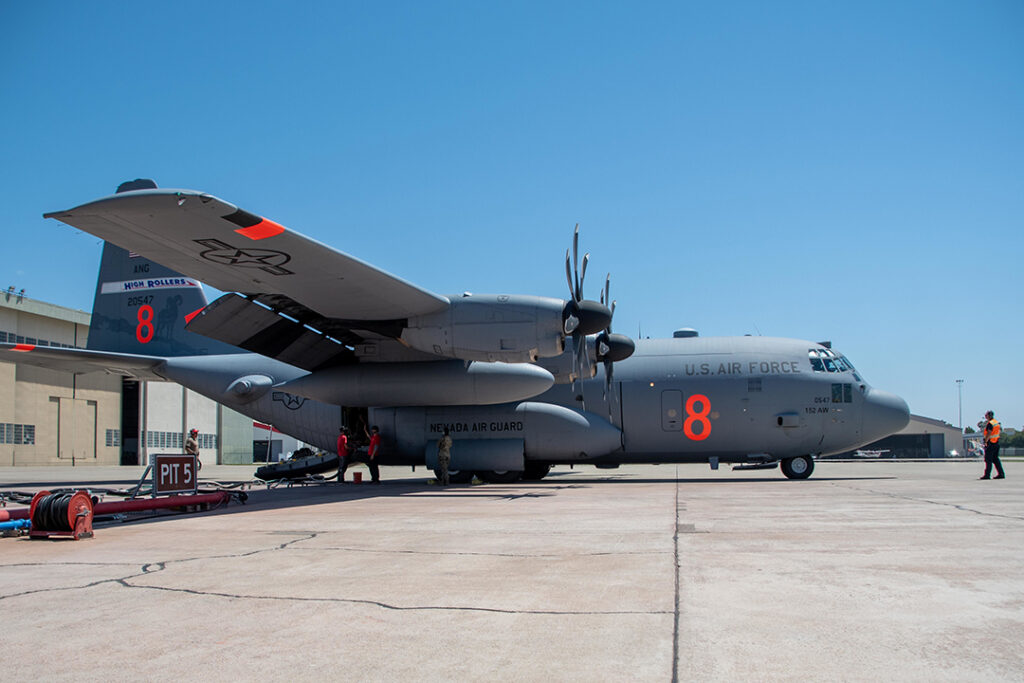THE WATCH STAFF
The U.S Air Force recently ended its second-busiest season in nearly 50 years of battling wildfires.
Air crews flying C-130 transport aircraft carried out 945 sorties in California, dropping 2,583,204 gallons of fire retardant in 2021, according to U.S. Northern Command (USNORTHCOM). That total is the second highest since the military program using the Modular Airborne Fire Fighting Systems (MAFFS) was established in the 1970s, and it was surpassed only by the 1994 fire season, according to USNORTHCOM.
MAFFS units are requested through the USNORTHCOM commander to provide support to the National Interagency Fire Center in conducting U.S. wildland firefighting operations.
The MAFFS program, which converts the C-130s into tankers to provide emergency support to commercial aircraft battling wildfires, is a joint effort between the U.S. Forest Service (USFS) and the Department of Defense (DOD).
(Pictured: An Air National Guard C-130 of the 152nd Airlift Wing in Reno, Nevada, is loaded with fire retardant July 13 at McClellan Air Tanker Base, Sacramento, California.)
The USFS, citing more favorable weather conditions in the western U.S. and an increased availability of commercial airtankers, released the final four C-130s from the mission on September 29, marking the end of 96 days of support, the news release said.
“This was an exceptional year that saw each unit contribute to a highly successful interagency firefighting effort,” Lt. Gen. Kirk Pierce, commander of 1st Air Force (Air Forces Northern), said in the USNORTHCOM statement.
Air Forces Northern, which is USNORTHCOM’s air component command, is the DOD’s operational lead for the firefighting efforts. One Air Force Reserve Command and three Air National Guard locations participate in the program, which consists of eight aircraft.
The 302nd Airlift Wing (AW) in Colorado Springs, Colorado, is the Reserve unit. The Guard units include the 152nd AW in Reno, Nevada; the 146th AW in Channel Islands, California; and the 153rd AW in Cheyenne, Wyoming.
In one instance in August, all eight MAFFS C-130s were fighting fires, something that had not happened since 2012, according to USNORTHCOM.
The C-130s equipped with the MAFFS can drop up to 3,000 gallons of fire retardant in less than 10 seconds across a quarter-mile line, according to an October 6 story in the Stars and Stripes newspaper and an Air Force fact sheet. The USFS system, which consists of five pressurized fire-retardant tanks and associated equipment, slides into the C-130’s cargo bay, and the retardant is released through a nozzle on the rear left side of the aircraft, according to Stars and Stripes. After a C-130 discharges its load and returns to an air-tanker base, it can be refilled and airborne again in less than 20 minutes, according to the fact sheet.
“The [Forest Service] and other federal wildland fire agencies appreciate the continued military support through the MAFFS program,” Kim Christensen, deputy assistant director for operations for the USFS, said in the USNORTHCOM news release. “They provide a valuable contribution to our wildland firefighting efforts and we’re proud to have them working alongside us. We also appreciate their focus on safety in all aspects of their operations.”
If additional support is required for the 2021 fire season, the crews and planes can be activated within 48 hours, according to USNORTHCOM.
IMAGE CREDIT: SENIOR MASTER SGT. PAULA MACOMBER/U.S. AIR NATIONAL GUARD

